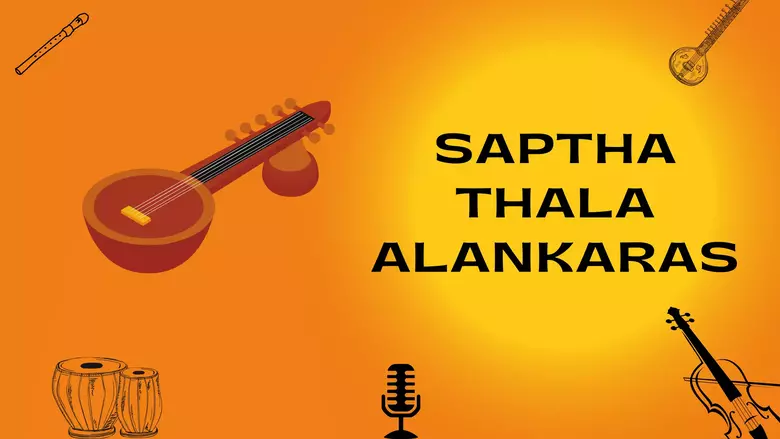Saptha Thala Alankaras is a set of seven basic Carnatic music compositions, which form the foundation of Carnatic music learning. Each one has its unique flavor and character, and learning to play and sing with proper intonation is essential for developing a solid musical foundation. Alankaras are musical ornaments that decorate the ragas (melodic structures) in Carnatic music. In this blog post, we’ll take a closer look at each of the Saptha Thala Alankaras and learn how to utilize them to create beautiful melodies. We’ll also discuss some of the essential benefits of this to begin incorporating them into your playing and singing. Let’s get going!
1. Chathurasra Jathi Dhurva Thalam
Dhruva Talam is the first alankara and the most important of all the Saptha Thala Alankaras. This alankara has four beats and reflects the four seasons of the year.. This Tala consists of one Laghu, one Dhruta, and two Laghus. Laghu is a rhythm that begins with the little finger and progresses through the ring, middle, and middle fingers. The number of digits defines the Laghu’s count.
For Dhruva Thalam, each Laghu has a total of four counts. Beats and waves make up the Dhruta sound. There are two types of Dhrutas. Again, Dhruva talam has a break-up as laghu, dhruta, laghu, and laghu, which consists of four elements. Each avartana (cycle) has fourteen beats, which are split as follows: 4,2,4,4.
2. Chathurasra Jathi Matya Thalam
The second alankara in Saptha Thala Alankaras is Matya Talam. This Tala consists of one Laghu, one Dhruta, and one Laghu. Laghu is a finger-counting pattern that begins with the little finger, progresses through the ring finger, and lastly to the middle finger… The jaathi determines the number of counts in the Laghu; for Matya Talam, each Laghu has four counts. A wave follows a beat in Dhruva. There are two counts in a Dhruva. Matya talam is broken up as laghu, dhruta, and laghu, with 4, 2, and 4 beats
3. Chathurasra Jathi Rupaka Thalam
The third of the Saptha Thala Alankaras is Rupaka Talam. One Dhruta is followed by one Laghu in this Tala. A wave follows a beat in Dhruva. There are two counts in a Dhruva. To count a Laghu, you start with the little finger and work your way up to the ring and middle fingers.. The jaathi determines the number of counts in the laghu; for Chaturasra Jaathi, each laghu has four counts. Likewise, Rupaka Talam features a dhruta, laghu break-up, with 2, 4 beats every avartana or cycle, for six beats per avartana or cycle.
4. Misra Jathi Jhumpa Thalam
The fourth of the Saptha Thala Alankaras is Jhumpa Talam. This Tala consists of one Laghu, one AnuDhruta, and one Dhruva.Laghu is a rhythm counted on the fingers, beginning with the little finger and moving up to the thumb before returning to the little finger. The jaathi governs the number of counts in the Laghu; for Misra Jaathi, each Laghu has seven counts. The AnuDhruta is a single-count palm beat. Jhumpa Talam has a laghu, anudhruta, dhruta break-up, with 7, 1, and 2 beats each avartana or cycle for ten beats.
5. Thisra Jathi Triputa Thalam
The fifth of the Saptha Thala Alankaras is Triputa Talam. Two Dhrutas follow one Laghu in this Tala. A Laghu is a rhythm counted on the fingers, beginning with the little finger and progressing to the ring finger. The jaathi governs the number of counts in the Laghu — each Laghu has three counts for Triputa Talam. A wave follows a beat in Dhruva. There are two counts in a Dhruva.
Triputa Talam is broken down as Laghu, Dhruta, Dhruta, with 3, 2, 2 beats every avartana or cycle for a total of 7 beats. The most popular Tala in Carnatic music is Adi Tala, a Triputa Tala variation. With 4, 2, and 2 counts in Laghu, Dhruta, and Dhruta, for eight beats or counts every cycle, it’s also known as the Triputa Tala.
6. Khanda Jathi Ata Thalam
The sixth of the Saptha Thala Alankaras is Ata Talam. Two Dhrutas follow two Laghus in this Tala.
A Laghu is a finger-counting beat that starts with the little finger and progresses through the ring, middle, and index fingers. The jaathi determines the number of counts in the Laghu; for Ata Talam, each Laghu has five counts. A wave follows a beat in Dhruva. There are two counts in a Dhruva. Again, Ata Talam consists of four beats: Laghu, Laghu, Dhruta, Dhruta, for a total of 14 beats every avartana or cycle.
7. Chathurasra Jathi Eka Thalam
The seventh of the Saptha Thala Alankaras is Eka Talam. This Tala consists of only one Laghu, or beat, followed by counting on fingers from the little to the middle finger. Per Laghu, Eka Talam
has a total of four counts. Moreover, Eka Talam has only one Laghu with four counts.
Benefits of Learning Saptha Thala Alankaras in Carnatic Music
Some benefits of learning Saptha Thala Alankaras in Carnatic music are:
- It helps to execute various gati patterns
- Enables one to identify different talas (rhythmic cycles) more easily
- Facilitates correct counting of beats while singing or playing an instrument
- Helps to improve memory and concentration
- Can help gain a better sense of timing and coordination while playing or singing swaras
- This may lead to a deeper understanding of the mathematical aspects of Carnatic music.
[TABS_R id=13393]
Conclusion
In this blog post, we’ve looked at the seven Saptha Thala Alankaras and their benefits for learning. If you want to take your playing to the next level, make sure you practice these alankaras regularly with our professional carnatic music institute and see how they can help improve your timing, phrasing, and overall musicianship. Do you have any questions about these concepts or anything related to Carnatic music? Let us know in the comments below.
Related Blog: Lesson 9 : Swarajathis, Lesson 4: Uppersthayi






























